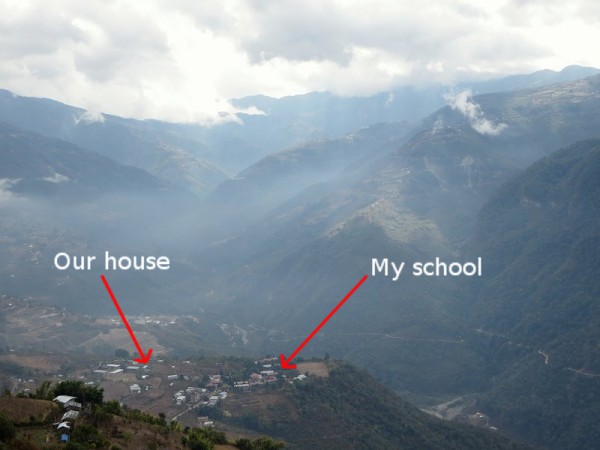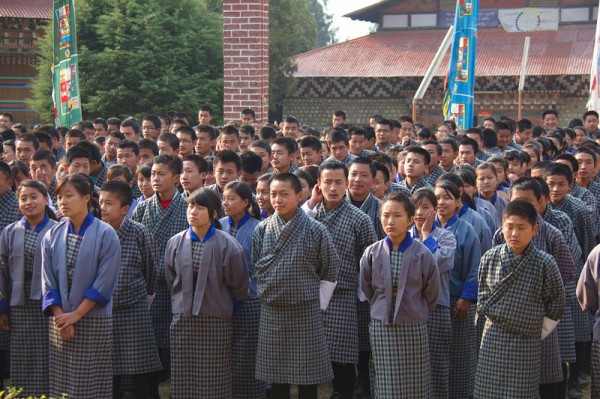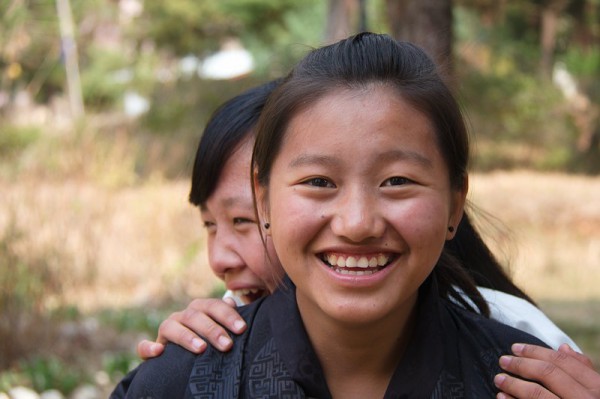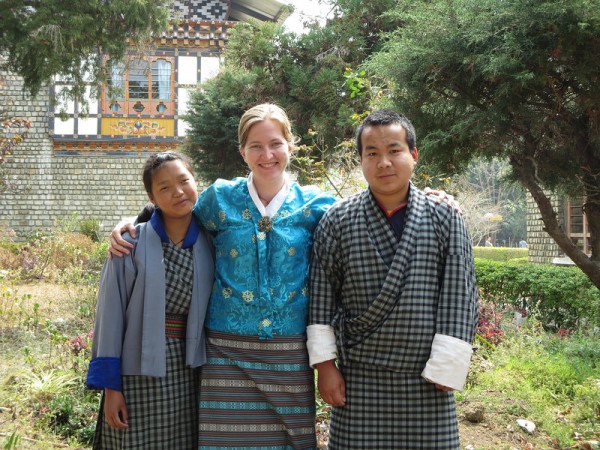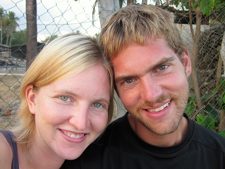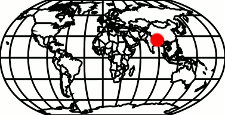Note from Ashley: After a month and a half of living in and falling in love with Nangkor, Mike has returned to the capital, Thimphu, to try a new adventure. He will be substitute teaching for about the next two months for a fellow BCF teacher that is on leave. I, of course, am still in Nangkor teaching at the higher secondary school. This marks the first time that we have spent more than a week apart in the 11 years we’ve been together.
I’ve now traveled to and from Thimphu in the west and our village, Nangkor, in the east. Looking at numbers, it would appear to be no big deal. As the crow flies, we are only talking about 400 km, with a grand total of only 600 and some kilometres if you take into account all the curves in the road.
But, it is a bit of a big deal. The highway is a partially paved, cliff-skirting, mountain climbing, twisting, single lane roadway. There are no speed limit postings but, in a way, that makes sense. There’s just no need for them. I’ve heard tales of drivers who have gone as fast as 50km/hr, but that was a once-in-a-lifetime top speed, reached for mere seconds. The majority of traffic seems to move somewhere between the speed of walking and about 30 km/hr – not including stops for road construction, of course (the road is being widened so this post stands the chance of becoming an outdated relic in the near future).
With that perspective, I can now tell you that our trip from Thimphu to Nangkor took us a total of five days. In fairness, we were making a lot of stops, as we had 16 new teachers, not including ourselves, to drop off along the way. I’m also happy to report that I’ve just beat my previous record in the reverse direction. Only four days this time!
Hitching
Truth be told, I don’t do much hitchhiking. I’m usually happy enough to take a bus (except in Canada where it’s cheaper to drive a rental car). But, Bhutan is special. It’s unlike any other country I’ve visited, in a very good way. For one, there’s virtually no violent crime. Second, people are friendly and helpful. Nearly every passerby stops to ask where I’m going even when I’m not trying to hitch a ride, and there’s nearly a 100% chance that any car passing will stop to pick me up if they have the space to squeeze me in. Third, I have those 16 teachers scattered along the road who can give me a place to spend the night. Considering this, hitchhiking seemed like the best possible mode of travel available to me.
First Stop – Khaling
Easy as pi. I started out at 8:30AM. Before I had taken my 100th step along the road I was comfortably seated inside a vehicle. The driver took me up the hill to Pemagatshel Dzong. From there I waited only 10 minutes before a gypsum truck pulled over and took me to the highway junction. I’d already come a good distance considering it was just time for lunch. I sat by the road and consumed some of my travel snacks. Like magic, just as I finished my last bite of cracker, I had my next ride. It was the blood truck headed to Mongar Hospital with fresh donations. The driver spoke incredibly good English. We chatted about Canada, Bhutan, Sharshopka, the hospital, the guy who got an arrow in the eye during Losar, trekking, and Buddhism all the way to Khaling. I could have kept going all the way to Mongar, but I had already planned to visit my friends Brett and Angie for the night. Here’s what’s crazy though. None of the drivers would accept a single cent from me despite the fact that I offered. Even more, the driver headed to Mongar exchanged phone numbers with me and bought me tea and lunch before saying goodbye.
It was great catching up with Brett and Angie. Brett the chef, cooked a nice meal and shared some of his private scotch reserve with me. Not to mention the rare gift of brewed coffee. A resounding success for the first day.
Second Stop – Kilkhar, Mongar
Mongar is not that far from Khaling, so I had a leisurely morning and started a little later than the day before. It was nearly 10:30 by the time I hiked up to the highway. I was a little eager to stretch my legs, so I started walking. I had made it less than 1km before a mechanical engineer picked me up. He works for the Bhutan Power Corporation and was on his way home. We had a lot to talk about, as I’m also an engineer, and I too used to work for a power corporation. The time flew by, and before I knew it I was standing right outside Paul’s house, where I spent the night.
I was rather lucky to arrive the day that I did. Paul was invited out to a birthday party, and I was asked to come with. I got to meet a good portion of the staff that Paul works with – who, of course, ensured that I was well-fed and watered. We sang and danced until the middle of the night to a mix of traditional Bhutanese songs, western dance songs, and the chicken dance (which was a smash hit amongst both children and adults)!
At the party, I was told that hitching a ride between Mongar and Bumtang would be nearly impossible. Partly because I wanted to leave Sunday morning, and there would be little to no traffic, and partly because I’d be going up the mountain. Assuming that I could only find a ride part way, I’d have to be prepared for the cold. Which I wasn’t.
It turns out the bus is reasonably cheep 615Nu ($12CAD), so I didn’t fight the advice. I had to get up early, which was a bit of a feat after the wild night before, but I managed to get there in time to purchase the last ticket to Thimphu.
Day 3 – Chumey
It took 9 hours on the bus to reach Jakar in Bumtang. During the day, I met a wood carver from Mongar who is planning to start work on a monastery alter in Pemagatshel soon. We exchanged phone numbers so that I could see his work once he got started. His English was very good and he helped me to communicate with the driver. My intention was not to spend the night at the hotel where the bus had stopped, but to press on to Chumey and visit the Diver family for the night. This entailed a morning pickup on the highway from the bus driver.
As luck had it, the Divers were in Jakar shopping, so it was easy enough to meet up with them and share a cab back to their house. Again, it was nice to share a good meal and conversation. In the morning, I received some homemade bread for the road, which I found a real treat, and the bus picked me up as planned.
Day 4 – Thimphu
My friend the wood carver wasn’t on the bus today, He wasn’t planning to go past Bumthang. I was a little worried that I wouldn’t have anyone to talk to the whole day, but I needn’t have been. The lady who I had been sitting beside all 9 hours the day before greeted me with a few simple words in English when I was picked up in the morning and it didn’t take long before we were conversing in a mix of Sharshopska and English. She taught me some new words, and we were able to tell each other about our families and their various jobs.
During a lunch stop, I randomly met an agriculture officer who is working on a project near Chamgang, the village that I’m relocating to. Again we exchanged phone numbers and promises of meeting again.
There was a little excitement on the bus when a taxi driver passed us, stopped on the middle of the road in front of us, then got out and began yelling at our bus driver. I have no idea what it was about, but it did escalate to fisticuffs. At one point, the taxi driver jumped into the bus seat and let go of the brake. There was a moment of panic while everyone scrambled to get off the bus, and the men outside manhandled the taxi driver to the ground.
Shortly after, the whole ordeal just kind of ended. The taxi driver got back into his taxi and sped off into the sunset. I’m still baffled as to what it was all about. I don’t think I’ve witnessed someone raise their voice in this country, let alone fight. It’s hard to describe how out of place the whole thing seemed.
Anyway, I had a pretty good time hitching and bussing my way around Bhutan. On my way back towards Nangkor, I intend to do it again. Perhaps with more hitching and less bussing. I’d share some photos, but my internet just isn’t good enough to do it right now. Stay tuned for when I find a free wifi connection.
